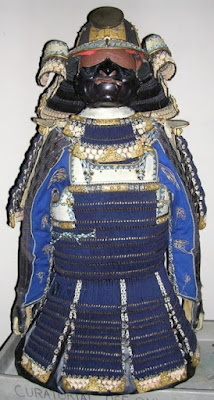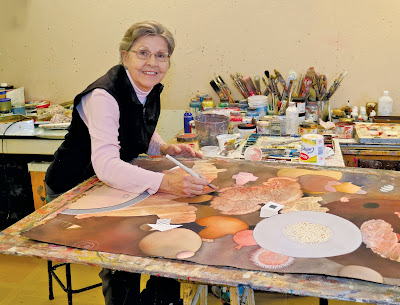One of the joys of working in the Museum's Education Department is greeting the students arriving for their field trip tours, which are on hold for now. As students gather in the Lancaster Lobby, you can hear excited snippets of conversations and sense their enthusiasm and anticipation. Students then break into groups and meet the docent who will take them on their journey through the galleries. Museum staff and visitors can see the students as they ask questions and view art from around the world. When the students return to the lobby to gather back together, there is much chatter about their experiences. We're always curious what they thought of everything they saw.
 |
| . |
One window we have into their time at the Museum is through the thank-you letters we receive from students. We love reading these letters! The notes are incredibly insightful and honest. As Jan Ewick, our school tour supervisor, was departing after 30 years with the Museum, she shared the file of letters she kept in her desk. Here, we share a sampling of these treasured thank-you notes from students who visited WAM on a field trip and also from those students who had a docent bring the Museum to their classroom.
This April 1996 letter from Nora stands out because of this future archaeologist’s enthusiasm for the classroom visit from a WAM docent.
Dear Louise,
Thank you very much for your effort and the time you spent with us. I really appreciated the information about Ancient Egyptian art and life. It helped a lot with the planning of our pyramid. My friend Angela and I are planning to move to Egypt and work as archaeologists in Giza and the Valley of the Kings. Your activities on hieroglyphics have helped us determine what to write in our plans. Thanks again.
Sincerely, Nora
This letter from the same visit shows a wide range of
enthusiasm for the Egyptian topic in the classroom.
Dear Louise,
Thank you so very much for coming to Miss Greene’s sixth-grade classroom. I enjoyed having you come to our class and talking to us about Egypt. Some people didn’t like doing the things that you gave us to do. But I did. I enjoyed every bit of it. When you first came I thought, "Boy I would love to know all the stuff she does." But truly I really did enjoy having you come to our class, and hope you can come again.
Sincerely, Nikki
Many people, including our student visitors, are curious if the works on view are replicas. They often voice that the artwork looked
“real.” Students also are often surprised and appreciate seeing the
contemporary works along with the ancient works. This letter from Donny
mentions both of these aspects from his February 2017 note.
Dear Worcester Art Museum,
Thank you for opening the museum early so that we can see your work. The statue that interested me the most was the Knight in armor because he had a shield and other things on him. I also liked the mummy case because it looked like a real mummy. I saw a lot of pictures in one room that had a Rocket TV and the TV was really bright and colorful. I thank you Worcester Art Museum for showing us around.
Sincerely, Donny
One letter, in particular, from Amy in Florida, reveals many of the interesting questions we receive from students.
I am 9 years old and in fourth grade. I’m in art class. I have questions to ask about your museum. I am wondering if you buy or rent your paintings? Did anybody ever rob your museum? Do you have a kids museum? How do you get big art through the door? Do you have a restaurant? Why do you show Egyptian art? I think I have asked enough questions. May I please have some pictures of your museum?
Thank you, Amy.
Our WAM docents do a great job
of answering our student visitors’ questions and sharing how museums work.
Our fourth-grade Worcester Public Schools students can draw and write on their tours. They have specific works for their curriculum that they stop at and discuss with a docent. One artwork is Phillip Evergood’s The Rubber Raft (about 1945).
The
label for this work reads, “When this painting was included in the summer 1945
‘Contemporary American Painting’ exhibition at San Francisco’s California
Palace of the Legion of Honor, a reviewer for Time magazine singled it out as ‘a
war footnote in which two helpless, parched men sprawl on a raft surrounded by
voracious sharks.’ Like viewers today, the reviewer was no doubt captivated by
the bold, violent colors and dramatic draftsmanship that helped emphasize the
ominous storyline—as well as the detail of the vivid red mouths and snapping teeth
of the hungry sharks encircling the doomed sailors.”
Discussions of this work combined with students’ natural
curiosity in sharks have inspired many drawings that have been shared with us, like these here.
 |
Some of our student tours see work from the Middle Ages and meet Neal Bourbeau, our programming coordinator and resident knight, who shares the armor and stories of knights with them. The students honest reflections on their tours provide a glimpse of the work our docents and staff do to keep an excited group of students focused on the learning goals their teachers have for the visit! Here are some snippets from sixth graders’ thank-you notes.
 |
| Arms & Armor Presentations are popular with school children. Here, a field trip visitor participates in an interactive session with Neal Bourbeau, WAM program coordinator (right). |
Dear Neal & Mary,
I am a sixth grader who said that the sword is "shiny." I wanted to thank you for an amazing field trip we had today…I was surprised that dogs back then wore Armor. I like that Mary was still talking when my friends sometimes go wander off. Also that Neal was nice and that people said it was pretty fun. --Lexi
I am writing to you today to say thank you for the tour and excellent field work you have prepared for us. I have learned many new things on the visit. For instance, all of the heavy armor knights have to wear. I learned that the art work in the museum is thousands of years old. Thanks gain for the presentation because it was awesome. --Helen”
I am writing to thank you for teaching our group more about the medieval times. Even though my group was distracted with the iPads, you still wanted to keep going with the lesson. I learned a lot more that I didn’t know. --Jayda
We went to the Art Museum because we are learning about religions. I learned that Jesus when he was a baby looked more like an adult. Also that the armor they wore in the Crusades was really heavy. Some feedback that I have is you actually explained to us really good about the paintings and stuff we learned and you showed us more about their weapons and some of the armor they wore so thank you very much for being nice and sorry that we might of got off track.--Carina
I really loved the tour and the beginning when we got to learn about the things they wore to battle. The tour was awesome because we got to see paintings and sculptures they made. The things that people got to wear was also cool because they got to see what is feels like. Thanks so much! --Lindsay”
Honestly I think you guys did an awesome job presenting. You did an awesome job about explaining everything carefully. Keep up the good work and keep putting smiles on people’s faces.--Justin
This last letter is one we've treasured for many years and reminds us of the importance of sharing works of art with young visitors. Students can learn important history and visualize techniques of creating art from our collection, but they also can find beauty and learn about themselves.
Dear Staff of the Art Museum,
I just wanted to let you know how much I enjoyed going to the Art Museum with my school and seeing all of the beautiful art work. Never in my whole life have I ever seen so many beautiful sculptures and paintings. Most of all I liked seeing the realism paintings. They were so graceful and real. Every time I look at them it makes me feel good about myself and happy to be here. I hope that next year I will get to go to the Art Museum again.
Sincerely, Cassie
 |
—By Aileen Novick, WAM's manager of public and education programs, and Jan Ewick, recently retired school tour supervisor at WAM
December 15, 2020














































